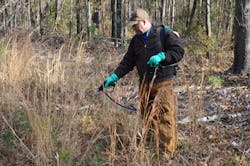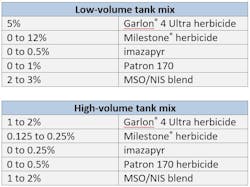Things don’t always go according to plan in vegetation management. Weather delays, labor shortages and other factors can have a big impact on the completion of planned treatment cycles during the foliar season.
But if any of those factors forced you to skip treating brush on your managed areas, there’s no reason to leave it until next year, when it will cost you more to treat. Dormant-stem treatments are an effective and economical solution to address incompatible brush postponed during foliar season. These applications can be made later in the fall, throughout the winter months and even into spring when many crews have put their application equipment up until the next growing season.
Here are five ways dormant-stem treatments can bring value to a vegetation management program:
They are effective. Utilities using these treatments properly have seen anywhere from 85% or better control on hardwoods such as maple and oak, as well as conifers such as hemlock, cedar and pine.
They are economical. Brush can grow between 20 and 40% from one year to the next. When that happens, it means needing more time and material to treat what’s now grown into a harder-to-control problem. In fact, field research from Corteva Agriscience has shown that delaying routine maintenance by one growing season can double your maintenance costs.
They reduce public scrutiny. Depending on application timing and species, many targeted plants simply don’t leaf out in the spring following dormant-stem application, so there is no visible brown-out effect (except on evergreen species). This reduces public visibility, scrutiny and potential complaints.
They extend treatment windows. Finally, dormant-stem applications provide the opportunity to expand treatment windows. This timing offers the opportunity for a reallocation of work crews from late to early in the season (at a time when most crews are shutting down).
They can be selective. Finally, applicators can use selective herbicide mixes for dormant-stem applications. That means early spring greenup for grass and other desirable plants. An example of a broadcast selective mix is included below.
Tank-mix recommendations
Dormant-stem applications are well-suited and beneficial for use on many utility use sites. Below are two charts containing recommended tank mixes with herbicide rate ranges for these treatments — including a low- and- high-volume mix for utilities.
These rates are recommended for low- to high-brush density with stem diameters of 3 inches or less at heights up to 8 to 10 feet tall. Rates will vary by target vegetation and brush density.
Treatments should be made between fall leaf senescence and up to 25% plant leafout. The application technique is similar to foliar applications; however, there is no foliage to spray (except with evergreen species such as conifers, which are treated the same as dormant deciduous trees). Contact your local VM specialist from Corteva Agriscience for more comprehensive training and customized solutions, and always read and follow all labeled rate restrictions.
Sponsored by:
™®Trademarks of Dow AgroSciences, DuPont or Pioneer, and their affiliated companies or their respective owners. When treating areas in and around roadside or utility rights-of-way that are or will be grazed, hayed or planted to forage, important label precautions apply regarding harvesting hay from treated sites, using manure from animals grazing on treated areas or rotating the treated area to sensitive crops. See the product label for details. State restrictions on the sale and use of Garlon 4 Ultra and Milestone apply. Consult the label before purchase or use for full details. Always read and follow label directions. © 2019 CORTEVA.


